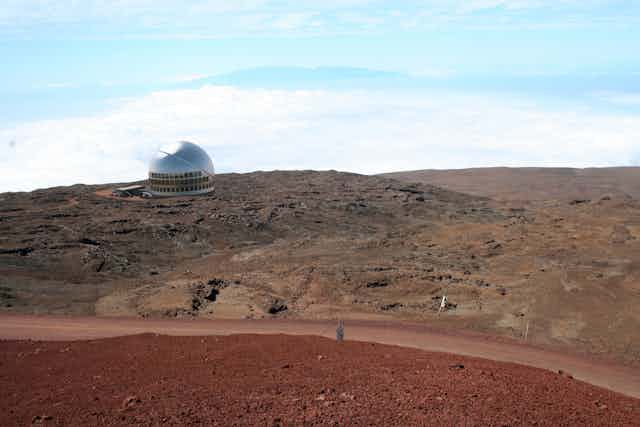Plans to build a new telescope on Mauna Kea in Hawai'i have led to months of protests and arrests, including several earlier this month. The ongoing protest pitches astronomers against Hawaiians wanting to protect their sacred site.
Conflict between Indigenous and Western interests are part of a long history of colonisation and exploitation. In the Amazon, indigenous communities are fighting governments that exploit the rain forest for natural resources. In the United States and Canada, First Nations people are battling mining and oil interests.
In Western Australia, Aboriginal people are finding their 30,000 year old rock art sites being deregistered as sacred because they must be “devoted to a religious use” rather than be “a place subject to mythological story, song, or belief”. Many of these sites are in areas of industrial expansion.
If the traditional custodians of the land reject proposals for development, they might face aggressive legal action. “No” is rarely a good enough answer for those exploiting the land, and seeking permission from indigenous people often smacks of tokenism rather than a real attempt to address the wrongs of the past.
The mountain of Wakea
Unfortunately, it is not just economic interests that put pressure on indigenous communities. Scientific interests prove another challenge to indigenous land rights. One such case is the development of the Thirty Meter Telescope (TMT) in Hawai'i.
On Hawai'i’s Big Island stands Mauna Kea, a dormant volcano towering 4,200 meters above sea level. Its high elevation and excellent atmospheric conditions make it an ideal place for astronomers to observe the stars. Mauna Kea is named for the god Wakea, the “sky father” – Mauna a Wakea. It is Hawai'i’s most sacred place.
It is important to note here that only people of Indigenous Polynesian Hawaiian heritage are called “Hawaiian”. Non-Indigenous people born in Hawai'i are called “Kama'aina” meaning “child of the land”, or “people of Hawaii” in general conversation.
Hawaiian reverence for Wakea meant that in ancient traditions only the Ali'i (high chiefs) were allowed to climb to its summit, where their most sacred ancestors are buried. It is here that astronomers plan to build a US$1.5-billion telescope with a primary mirror measuring 30 meters across.

The TMT offers potential scientific discoveries as well as economic benefits for the island. Currently there are 13 telescopes atop Mauna Kea but many Hawaiians are angry about the push to add more telescopes to the mountain, insisting enough is enough.
A resurgence of Hawaiian culture and language has led to the reclamation of sacred sites, including Mauna Kea, as areas of high cultural significance. Hawaiians wanting to preserve their cultural heritage are now clashing with proponents of the TMT. In recent months, protesters have blocked access to the mountain, halting development of the telescope.
An ongoing concern
Should astronomers be allowed to build the TMT on Mauna Kea? This question raises concerns that we, as practising astronomers, see as a reoccurring issue within the scientific community.
It is disheartening and frustrating to witness fellow scientists dismiss the connections indigenous people have to their land. We cannot simply disregard these connections as myths and legends, and comparing TMT protesters to Biblical Creationists is disappointing.
This is not a battle between religion and science. Hawaiians are not anti-science; they are not trying to push their traditional beliefs on others nor are they trying to stifle scientific and economic advancement. They simply oppose construction of yet another telescope on their sacred mountain.
We need to recognise and respect the close connection Hawaiians have to sacred sites like Mauna Kea and not misappropriate Hawaiian astronomical traditions for the benefit of astronomers.
The TMT demonstrates a microcosm of the challenges indigenous people face when their traditions are dismissed by Western interests for intellectual or economic gain.
Moving forward together
We acknowledge that some Hawaiians do in fact support the TMT, while others are calling for the removal of all telescopes. Governor David Ige offered one compromise: the removal of a quarter of the existing telescopes before building of the TMT commences.
We do not have a convenient solution to this issue. So how do we move forward together?
We can look at successful collaborations between scientists and indigenous people on other projects for guidance. The development of the Square Kilometre Array radio telescope in Western Australia was a result of close collaboration and ongoing consultation between astronomers and the traditional owners of the land.
We can take inspiration from the Polynesian Voyaging Society and Hoku'lea – the Hawaiian voyaging canoe. By working closely with artisans, navigators, astronomers, and historians, Hawaiians are reclaiming their ancient knowledge and in turn are sharing this with the world.
These two examples suggest nurturing mutually respectful relationships is the key to overcoming conflict.
This is a highly complex issue. We astronomers need to acknowledge that we do not have an inherent right to develop Mauna Kea. And if a consensus cannot be reached we must be willing to consider a different home for the TMT.

